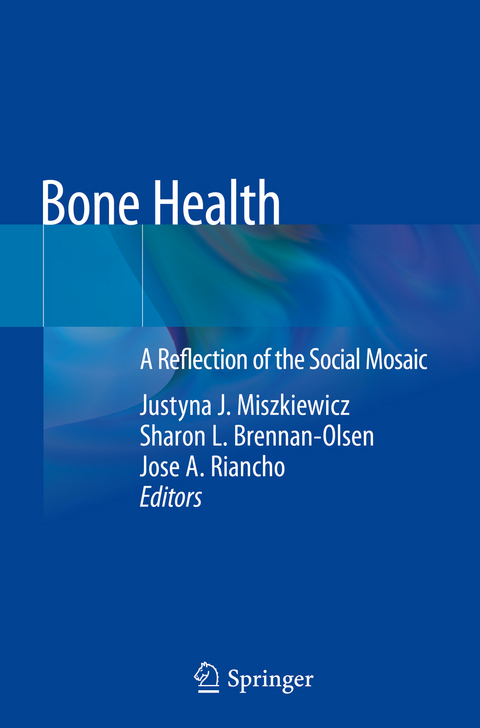
Bone Health
Springer Verlag, Singapore
978-981-13-7258-2 (ISBN)
The book is divided into three major parts, the first of which discusses bone and dental health in medieval human skeletal remains from distinct socio-economic status groups. In turn, Part 2 reviews bone health in contemporary human populations with a range of social backgrounds; in addition, a conceptual model proposing a social gradient of osteoporosis and fracture risk related to biological mechanisms and cumulative stressors throughout the human lifecycle is presented. Lastly, Part 3 highlights the role of epigenetics in socially patterned risk factors for skeletal disorders, and discusses how epigenetic mechanisms transduce the psychosocial environment and increase the risk of developing conditions such as osteoporosis.
Overall, the book highlights the importance of considering the social-biological nexus in future skeletal biology research and future treatment of bone disease. Increased awareness of this nexus can potentially improve individual and population-level bone health interventions, reducing the social inequities observed in fracture risk.
Given its scope, the book offers a valuable resource for researchers, academics, and students in the fields of medicine, epidemiology, the health sciences, biological anthropology, human anatomy and adaptation, developmental studies of human societies, human biology, and any field concerning musculoskeletal disorders and health. It will also benefit clinical practitioners evaluating osteoporosis, osteopenia, fracture risk, bone quality and quantity.
Dr Justyna Miszkiewicz is a Lecturer in Biological Anthropology who specializes in skeletal biology at the Australian National University, Canberra, Australia. She is also an Honorary Research Associate with the Skeletal Biology Research Centre at the University of Kent, Canterbury, UK. She has expertise in bone biological plausibility for associations between social adversity, social structures and trajectories of bone loss and maintenance in ancient human populations. Over the past several years, she has studied the effect of lifestyle on bone and dental quantity and quality in human skeletal remains from archaeological contexts, placing particular emphasis on the socio-economic stratification in medieval societies. Associate Professor Sharon Brennan-Olsen is a Principal Research Fellow at Department of Medicine-Western Health, University of Melbourne, Australia. She is a social epidemiologist and Program Director of ‘Social Epigenomics and Population Health’ at the Australian Institute for Musculoskeletal Science (AIMSS). Her research interests are the social determinants of musculoskeletal diseases and health service utilization, and the biological mechanisms that may underpin the social gradient of osteoporosis, sarcopenia and arthritis: in other words, how social and environmental exposures across the lifecourse influence the phenotypic expression of bone, muscle and joint diseases. Professor José A Riancho is professor of Medicine and director of the Department of Medicine and Psychiatry at the University of Cantabria, as well as chief of section of Internal Medicine at the University Hospital M. Valdecilla, both in Santander, Spain. He has extensive clinical experience in the management of patients with osteoporosis and other metabolic bone disorders. His research is focused on bone biology, osteoporosis and osteoarthritis. Current research lines include several clinical and translational projects, specially related to the genomics and epigenomics of osteoporosis and osteoarthritis. His research activities have received continuous funding by the Instituto de Salud Carlos IIII (Spanish Government) and other public and private institutions. He has published more than 200 papers in international peer-reviewed journals. He is a member of several scientific societies. He participates in several international consortia dedicated to investigate the genetic basis of skeletal disorders.
Section I: Medieval evidence.- Social status and bone health in the medieval times.- Adult bone density and strength across medieval social strata.- Physiological health disruptions inferred from dental growth data in medieval societies.- Section II: Contemporary evidence.- Bone mineral density across social groups.- Contemporary society and fracture.- Social gradient of preventive testing and treatment adherence in osteoporosis.- Section III: Epigenetic evidence.- Epigenetics at the crossroad between genetic and environmental determinants of disease.- The influence of maternal and social factors during intrauterine life.- Postnatal social factors, the epigenome and the skeleton.- Conclusions and future directions.
| Erscheinungsdatum | 27.07.2020 |
|---|---|
| Zusatzinfo | 18 Illustrations, color; 3 Illustrations, black and white; XXII, 186 p. 21 illus., 18 illus. in color. |
| Verlagsort | Singapore |
| Sprache | englisch |
| Maße | 155 x 235 mm |
| Themenwelt | Medizinische Fachgebiete ► Chirurgie ► Unfallchirurgie / Orthopädie |
| Medizinische Fachgebiete ► Innere Medizin ► Endokrinologie | |
| Medizin / Pharmazie ► Medizinische Fachgebiete ► Orthopädie | |
| Naturwissenschaften ► Biologie ► Humanbiologie | |
| Sozialwissenschaften ► Ethnologie | |
| Schlagworte | Bone mineral density across social groups • Effect of socio-economic status on bone health • Epigenetic factors affecting bone health • Lifestyle related bone disorders • Musculoskeletal disorders |
| ISBN-10 | 981-13-7258-6 / 9811372586 |
| ISBN-13 | 978-981-13-7258-2 / 9789811372582 |
| Zustand | Neuware |
| Haben Sie eine Frage zum Produkt? |
aus dem Bereich


